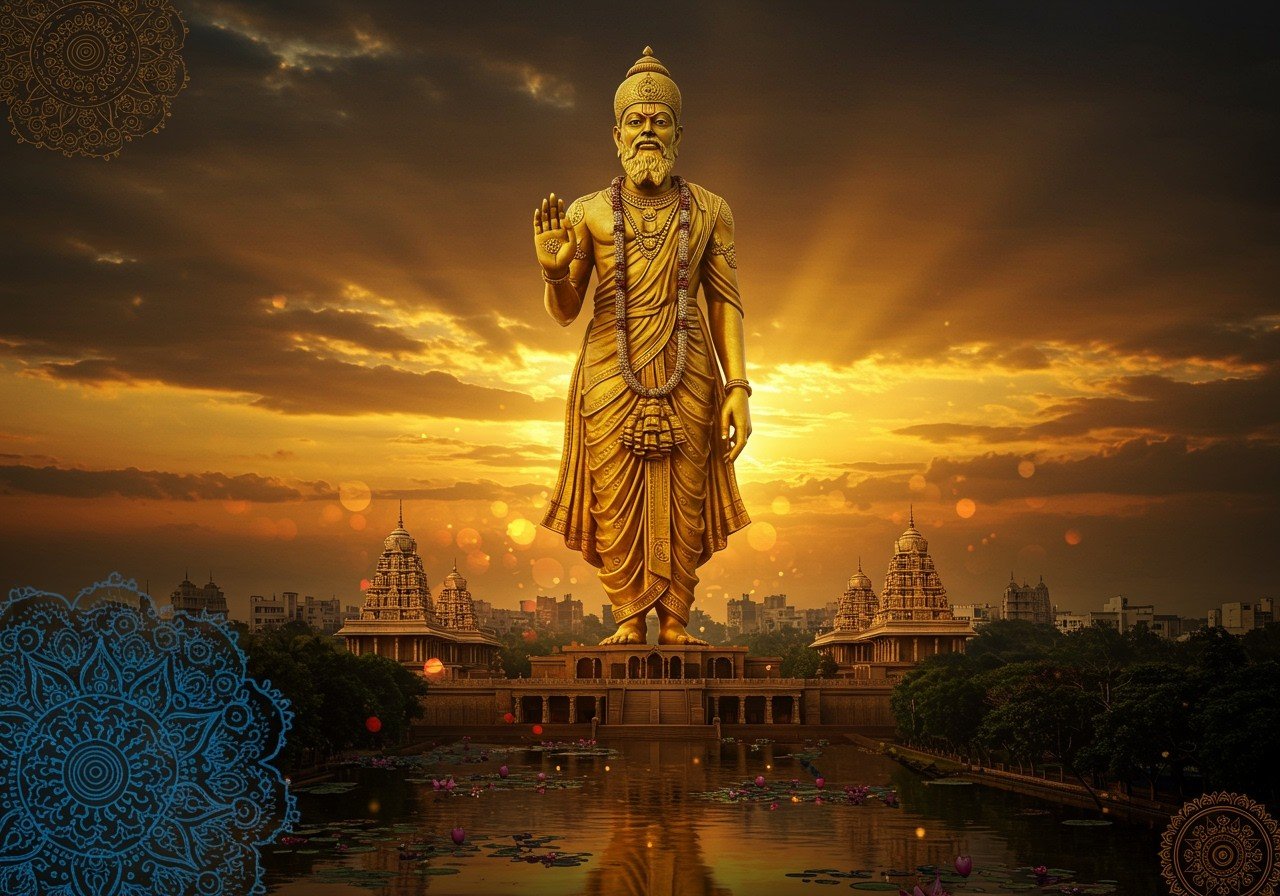
The Statue of Equality stands as a majestic tribute to the 11th-century Indian philosopher and social reformer, Sri Ramanuja. This colossal monument embodies cultural and spiritual significance, reflecting Ramanuja’s profound teachings on equality, devotion, and universal brotherhood. Located in Hyderabad, the statue serves as a beacon of his enduring legacy, resonating deeply with contemporary Indian society.
Location and Significance
Hyderabad, a city renowned for its rich cultural heritage, provides a fitting backdrop for the Statue of Equality. This strategic location complements Ramanuja’s values, offering easy accessibility for pilgrims and tourists alike. The city’s unique blend of traditional and modern architecture further enhances the statue’s prominence. Hyderabad’s logistical advantages also contributed to its selection as the ideal site for this monumental tribute.
Dimensions and Features
Rising an impressive 216 feet, the Statue of Equality commands attention as the world’s second tallest sitting statue. Crafted from panchaloha, a sacred five-metal alloy of gold, silver, copper, brass, and zinc, the statue symbolizes strength, resilience, and spiritual harmony, mirroring the values Ramanuja championed.
- The Base (Bhadra Vedi): The statue rests upon a 54-foot-high base building known as “Bhadra Vedi.” This structure, adorned with 36 elephants carrying 27-foot-diameter lotuses, adds to the monument’s visual splendor. Moreover, it houses a Vedic digital library and research center, preserving ancient Indian scriptures and ensuring Ramanuja’s wisdom endures for generations to come.
- Internal Features: Within the Bhadra Vedi, visitors will discover a wealth of resources, including a theater and an educational gallery showcasing Sri Ramanujacharya’s life and contributions. These spaces provide enriching experiences, allowing visitors to delve deeper into Ramanuja’s teachings.
- Inner Shrine and Surrounding Temples: A serene meditation hall houses a 120 kg gold statue of Ramanuja, commemorating his 120 years of life. The complex also features meticulously crafted stone replicas of 108 Divya Desams (sacred temples), showcasing intricate artistry and spiritual devotion.
Ramanuja’s Philosophy
Sri Ramanuja’s teachings emphasized equality and devotion, challenging societal norms prevalent in the 11th century. He advocated for unity and understanding, transcending barriers of caste, creed, and gender. His vision of the world as one family laid the foundation for social reform and inspired the Bhakti movement, promoting community service and personal devotion to God. These inclusive principles remain highly relevant today, guiding us towards harmony, respect, and acceptance.
Visiting the Statue of Equality
A visit to the Statue of Equality offers a profound opportunity to connect with India’s rich cultural and spiritual heritage. The cooler months provide the most comfortable climate for exploration.
- Facilities and Activities: Guided tours and meditation centers allow for immersive experiences, facilitating a deeper understanding of Ramanuja’s teachings and their contemporary relevance. These resources enhance visitor engagement and promote reflection on the statue’s significance.
- Nearby Attractions and Accommodation: Explore nearby historical sites and bustling markets to experience the vibrancy of Hyderabad’s culture. A range of accommodation options caters to diverse budgets, ensuring a comfortable stay for all visitors. Convenient transportation networks provide easy access to the monument, enhancing accessibility for a wider audience.
Cultural Significance and Community Impact
The Statue of Equality has become a cultural landmark, hosting events and festivals that celebrate Ramanuja’s philosophy. As an educational hub, it fosters awareness and understanding of his teachings. Community engagement initiatives focus on preserving his legacy and promoting dialogue on social equality. The influx of cultural tourism benefits Hyderabad’s local economy while disseminating Ramanuja’s message of unity and compassion globally. The statue stands not only as a tribute to a revered philosopher but also as a catalyst for positive social change within the community and beyond.
Poojn.in: Supporting Your Spiritual Journey
Poojn.in, India’s leading provider of cultural goods and services, offers a wide selection of authentic puja items to enhance your visit to the Statue of Equality. Whether you are seeking to perform rituals at the temple complex or create a personal shrine at home, Poojn.in has everything you need.
Explore our collection of puja samagri, including brass puja plates, clay diyas, and more. We also offer a curated selection of brass murtis of Sri Ramanuja and other deities. Convenient online ordering and nationwide delivery ensure you receive your items with care and respect.
Embracing Ramanuja’s Legacy
The Statue of Equality transcends its physical form; it embodies hope, unity, and wisdom. It serves as a powerful reminder of Ramanuja’s enduring legacy and his call for harmony, respect, and equality. Through cultural events, educational initiatives, and community engagement, the statue continues to inspire us to create a more just and compassionate world.
Frequently Asked Questions
Where is the Statue of Equality located? The Statue of Equality, dedicated to Sri Ramanuja, is situated in Muchintal, on the outskirts of Hyderabad, India.
What is the height of the statue? The statue stands at an impressive 216 feet tall, making it one of the tallest sitting statues globally.
Why is it called the Statue of Equality? The name reflects Sri Ramanuja’s core teachings, which emphasized social equality and universal brotherhood, transcending differences in caste, faith, or gender.
Who was Sri Ramanuja? Sri Ramanuja was an 11th-century Bhakti saint, philosopher, and social reformer who advocated for equality and inclusivity. His teachings profoundly impacted Indian society and continue to inspire generations.
What materials were used in its construction? The statue is made of panchaloha, a five-metal alloy consisting of gold, silver, copper, brass, and zinc, imbuing it with both strength and spiritual significance.
When was the statue inaugurated? The Statue of Equality was inaugurated on February 5, 2022, by Indian Prime Minister Narendra Modi. It’s a relatively recent landmark, yet it has quickly gained prominence.
What can visitors expect at the site? The surrounding complex offers a variety of experiences, including a Vedic digital library, a research center, a theater, an educational gallery, a meditation hall, and stunning replicas of 108 Divya Desams. It is designed to be educational, inspirational, and spiritually enriching.


